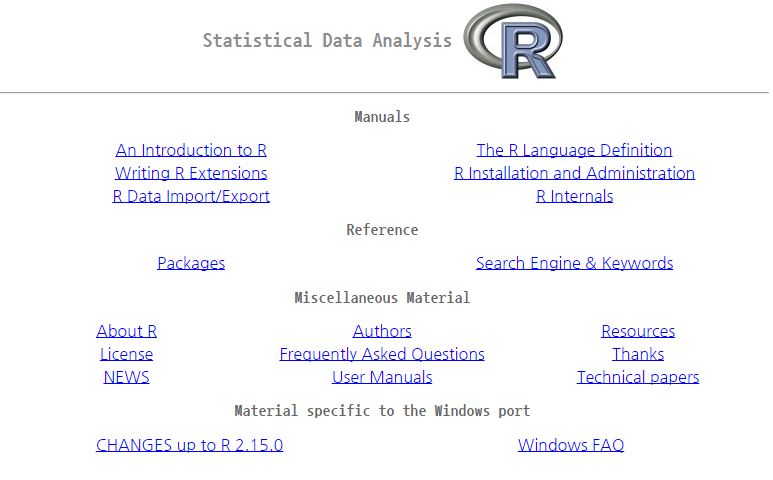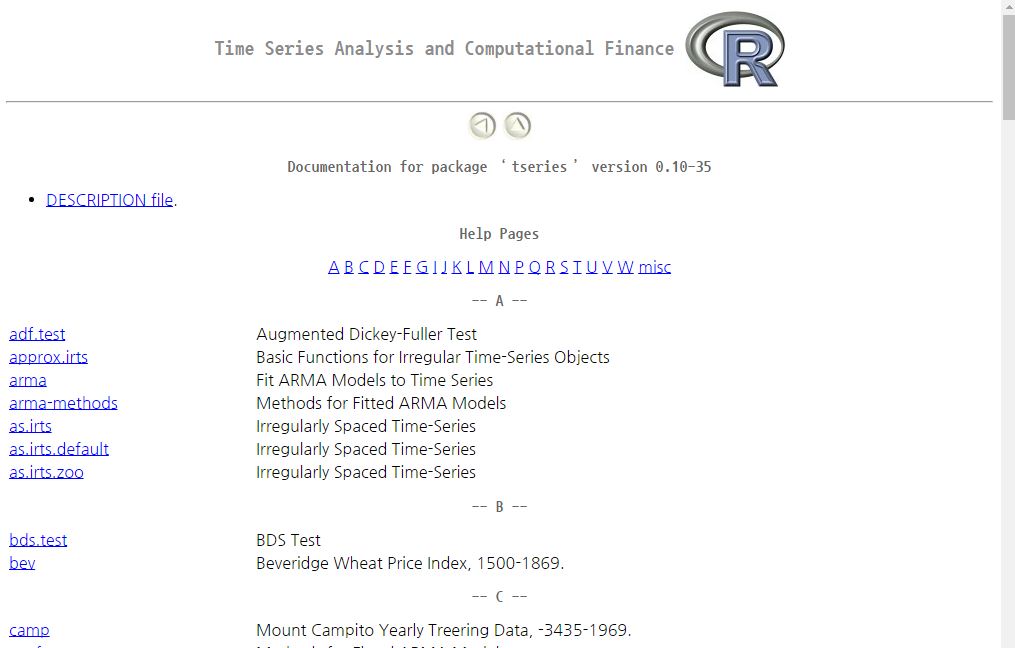This is an old revision of the document!
Table of Contents
Installation, base
Windows
- Open http://www.r-project.org/ in your browser.
- Click on “CRAN”. You’ll see a list of mirror sites, organized by country.
- Select a site near you.
- Click on “Windows” under “Download and Install R”.
- Click on “base”.
- Click on the link for downloading the latest version of R (an .exe file).
- When the download completes, double-click on the .exe file and answer the usual questions.
OS X
- Open http://www.r-project.org/ in your browser.
- Click on “CRAN”. You’ll see a list of mirror sites, organized by country.
- Select a site near you.
- Click on “MacOS X”.
- Click on the .pkg file for the latest version of R, under “Files:”, to download it.
- When the download completes, double-click on the .pkg file and answer the usual questions.
Linux or Unix
The major Linux distributions have packages for installing R. Here are some examples:
| Distribution | Package name |
|---|---|
| Ubuntu or Debian | r-base |
| Red Hat or Fedora | R.i386 |
| Suse | R-base |
Use the system’s package manager to download and install the package. Normally, you will need the root password or sudo privileges; otherwise, ask a system administrator to perform the installation.
Rstudio
Rstudio as a R tool
download for windows OS.
Starting R
Windows
- Click on Start → All Programs → R; or
- double-click on the R icon on your desktop (assuming the installer created an icon for you).
OS X
- Either click on the icon in the Applications directory or
- put the R icon on the dock and click on the icon there.
- Alternatively, you can just type R on a Unix command line in a shell.
Linux or Unix
- Start the R program from the shell prompt using the R command (uppercase R).
A trial
install.packages("NRAIA")
library(NRAIA)
detach(package:NRAIA)
trees summary(trees) boxplot(trees) pair(trees)
cars plot(dist~speed, data=cars) m.cars <- lm(dist ~ speed, data=cars) m.cars summary(m.cars)
chickwts summary(chickwts) boxplot(weight~feed, data=chickwts) anova(lm(weight~feed, data=chickwts) ## or . . . m.chck <- aov(weight~feed, data = chickwts) m.chck summary(m.chck)
t-test
ANOVA
Factorial ANOVA
correlation
regression
Multiple regression
Entering commands
> 1+1
> 1+1 [1] 2
max(1,3,5) [1] 5
max(1,3 ,5) [1] 5
Table 1-1. Keystrokes for command-line editing
| Labeled key | Ctrl-key combination | Effect |
|---|---|---|
| Up arrow | Ctrl-P | Recall previous command by moving backward through the history of commands. |
| Down arrow | Ctrl-N | Move forward through the history of commands. |
| Backspace | Ctrl-H | Delete the character to the left of cursor. |
| Delete (Del) | Ctrl-D | Delete the character to the right of cursor. |
| Home | Ctrl-A | Move cursor to the start of the line. |
| End | Ctrl-E | Move cursor to the end of the line. |
| Right arrow | Ctrl-F | Move cursor right (forward) one character. |
| Left arrow | Ctrl-B | Move cursor left (back) one character. |
| Ctrl-K | Delete everything from the cursor position to the end of the line. | |
| Ctrl-U | Clear the whole darn line and start over. | |
| Tab | Name completion (on some platforms). |
Exiting from R
On all platforms, you can also use the q function (as in quit) to terminate the program.
> q()
Note the empty parentheses, which are necessary to call the function.
Windows
- Select File → Exit from the main menu; or click on the red X in the upper-right corner of the window frame.
OS X
- Press CMD-q (apple-q); or click on the red X in the upper-left corner of the window frame.
Linux or Unix
- At the command prompt, press Ctrl-D.
Getting help
Use the help.start function to see the documentation’s table of contents:
> help.start()
> help.start() starting httpd help server ... done If nothing happens, you should open ‘http://127.0.0.1:25578/doc/html/index.html’ yourself
Packages
Click here to see a list of all the installed packages, both in the base packages and the additional, installed packages. Click on a package name to see a list of its functions and datasets.
Search Engine & Keywords
Click here to access a simple search engine, which allows you to search the documentation by keyword or phrase. There is also a list of common keywords, organized by topic; click one to see the associated pages.
Getting help from functions
Use help to display the documentation for the function:
> help(functionname)
Use args for a quick reminder of the function arguments:
> args(functionname)
Use example to see examples of using the function:
> example(functionname)
> help(mean)
> ?mean
> args(mean)
> example(mean)
> > example(mean) mean> x <- c(0:10, 50) mean> xm <- mean(x) mean> c(xm, mean(x, trim = 0.10)) [1] 8.75 5.50
mean> mean(USArrests, trim = 0.2) Murder Assault UrbanPop Rape 7.42 167.60 66.20 20.16
mean> colMeans(USArrests) Murder Assault UrbanPop Rape 7.42 167.60 66.20 20.16
Searching via Keywords
> help.search("pattern")
- A typical pattern is a function name or keyword.
- Notice that it must be enclosed in quotation marks.
> ??pattern
> help.search("social network")
Getting help on a package
> help(package="packagename")
> help(package="tseries")
> install.package("tseries")
Error: could not find function "install.package"
> install.packages("tseries")
Installing package into ‘D:/Users/Hyo/Documents/R/win-library/3.2’
(as ‘lib’ is unspecified)
--- Please select a CRAN mirror for use in this session ---
trying URL 'https://cran.ism.ac.jp/bin/windows/contrib/3.2/tseries_0.10-35.zip'
Content type 'application/zip' length 321067 bytes (313 KB)
downloaded 313 KB
package ‘tseries’ successfully unpacked and MD5 sums checked
The downloaded binary packages are in
C:\Users\Hyo\AppData\Local\Temp\RtmpmQCQRK\downloaded_packages
> help(package="tseries")
>
Searching the Web for help
> RSiteSearch("ANOVA")
Finding Relevant Functions and Packages
- Visit the list of task views at http://cran.r-project.org/web/views/. Find and read the task view for your area, which will give you links to and descriptions of relevant packages. Or visit http://rseek.org, search by keyword, click on the Task Views tab, and select an applicable task view.
- Visit crantastic and search for packages by keyword.
- To find relevant functions, visit http://rseek.org, search by name or keyword, and click on the Functions tab.


